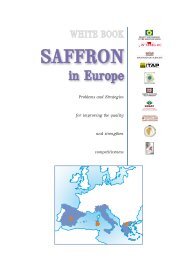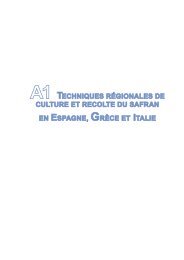Annex White book.pdf
Annex White book.pdf
Annex White book.pdf
You also want an ePaper? Increase the reach of your titles
YUMPU automatically turns print PDFs into web optimized ePapers that Google loves.
Seasonal phaseLengthInner diameterOuter diameterFiller thicknessCP-Sil 8 CB Low Bleed / MS30 m0,25 mm0,39 mm0,25 mmTable 15. Capillary column featuresA selective mass spectrophotometer detector is used (with an iondump that operates by electron impaction or chemical ionization) forpesticide detection, identification and quantitative analysis. The pesticidesare identified according to their absorption time and separationspectrum MS/MS which is unique for each analysis.A4.5 MICROBIOLOGICAL ANALYSISNo specifications regarding microbiological load are included in theISO/TS 3632:2003.The microbiological methods applied on the Greek saffron for microbiologicalload detection (aerobic MC/30 o C), yeast/mould and coliformorganisms (Eschericia coli) are those specified by ISO 4833, ISO 7954and ISO 16649-2 respectively.In Sardinia, the saffron samples were microbiologically analyzed in30, 60 and 90 days after sampling in order to see if a bacterial infectionoccurs during storage. A gram from each sample was homogenized.The suspension was subjected to decimal dilutions and 100 ul of eachsample of the various dilutions was inoculated in agar ROSE Bengalaplates (an isolation terrain for yeasts and moulds) and in PCA (PlanteCounte Agar) plates (microorganisms total tallying terrain).The Spanish law refers to the Technical Health Regulation regardingtreatment, distribution and marketing of spices due to absence ofa specified standard especially for saffron. According to the TechnicalHealth Regulation (RTS, mentioned before in section 5.1.3), the spicesshould not contain pathogenic microorganisms nor their toxins. Following,the highest admissible limits are: Escherichia coli (1 x 101 col/g),salmonella (absence in 25 g), and anaerobic spores (1 x 103 col/g). Forinoculation, cultivation and tallying of the microorganisms mentionedin the RTS, it is necessary to prepare a common sample that will besubjected to special procedures for each case. In order to receive mother169




